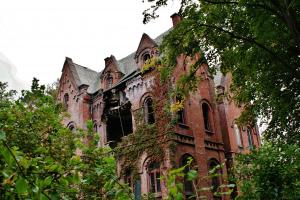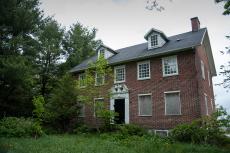It was supposed to be a quiet family trip. Destination: the province of Prince Edward Island and the Madeleine islands, a small archipelago consisting of a half-dozen of islands interconnected by bridges and roads. For readers outside of Canada,...
Wyndcliffe, the abandoned mansion
Ruin of a historic mansion
Wyndcliffe is the ruin of a historic mansion near Rhinebeck in Dutchess County, New York. The records at the Library of Congress state that the brick mansion was originally named Rhinecliff and Constructed in 1853 in the Norman style. The design is attributed to local architect George Veitch. The master mason, John Byrd, executed the highly varied ornamental brickwork using only rectangular and few molded bricks. The mansion was used a weekend and summer residence by its first owner, Elizabeth Schermerhorn Jones of New York City. The adjacent hamlet to the north of Wyndcliffe was originally platted as "Kipsbergen" (1686); the hamlet was later renamed as "Rhinecliff" after the Jones-Schemerhorn estate of the same name. Writer Edith Wharton was a frequent childhood visitor. The phrase "keeping up with the Joneses" is thought to originate from the Wyndcliffe estate.
Wyndcliffe was later known as Linden Hall or Finck Castle, for subsequent owners. The mansion was abandoned sometime around 1950. Originally situated on 80 acres including waterfront access to the Hudson River, the property was eventually reduced to 2.5 acres. Portions of the mansion have collapsed after many years of abandonment. In 2003 the mansion was purchased. The owner hopes to restore the mansion. As of 2012, the structure has continued to deteriorate.
Source: Wikipedia
Related content
This is the story of Mr. Chaume and his house. A house that was sold in the 1970s to my stepfather but the notarial act stipulated that Mr. Chaume,the seller, could stay in the house for free until his death. In the meantime, the buyer would not...
Built in 1875 in the Ahuntsic-Cartierville district located in the north of Montreal, Berri house is Second Empire style and has been part of the development of the sector, which began in the late nineteenth century. The city took possession of...
Located in the Eastern Townships, this loyalist manor house with its chic style reminiscent of the homes in New England. It seems abandoned for quite some time, although it is remarkably well preserved. There has been some vandalism in the rooms...























